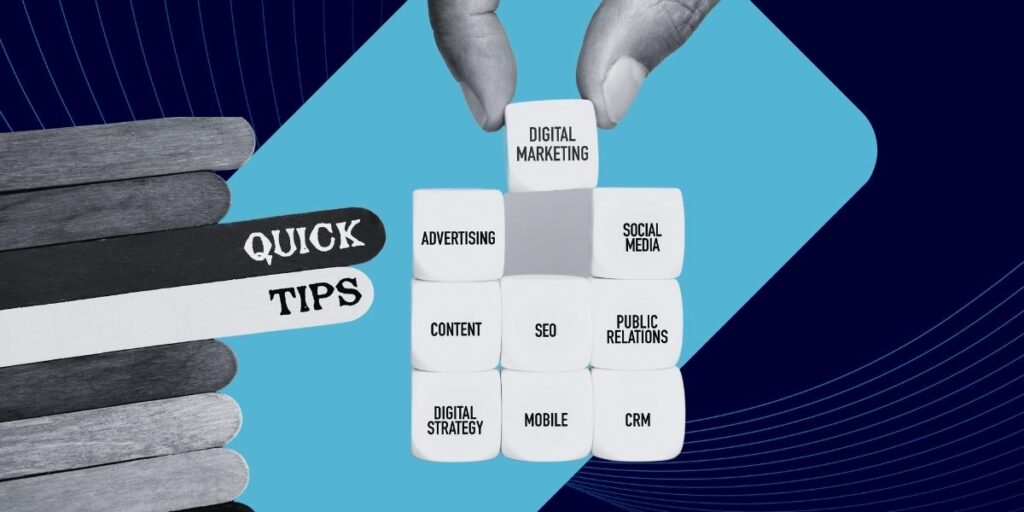Welcome once again to the Marketing Hawks blog! We’re thrilled to have you back. In our previous post, we shed light on some potent digital marketing tips aimed at launching your brand to greater heights.
Today, we’re taking this discussion a step further. Our esteemed Chief Marketing Officer, Ali, has put together an in-depth exploration of these strategies, offering valuable insights and pragmatic advice. This is all aimed at helping your brand maintain a competitive edge in the bustling digital market.
So, buckle up and prepare for an enlightening journey into the world of digital marketing tactics that have the power to redefine your brand’s online presence. Let’s get started!
Define Your Target Audience

Understanding your target audience is essential for crafting a marketing message that resonates with them. Here’s how to get to know your audience better…
1. Identify Demographics:
Start by identifying the demographic characteristics of your target audience. This includes age, gender, location, occupation, income level, and educational background. Knowing this information will give you a basic understanding of who your audience is.
2. Understand Psychographics:
Psychographics involves understanding your target audience’s attitudes, values, interests, lifestyles, and behaviors. This information can be gathered through market research and will provide more nuanced insights into what motivates your audience, what they value, and how they make decisions.
3. Conduct Market Research:
Market research, such as surveys, focus groups, and interviews, can help you understand your target audience better. You can use these techniques to gather information about your audience’s preferences, needs, and habits. It’s also a good way to identify trends or changes in your target market.
4. Analyze Customer Data:
Customer data can provide valuable insights into your target audience. This includes data from your website analytics, social media insights, customer feedback, and purchasing behavior. Analyzing this data can help you understand what type of content resonates with your audience, which products or services they prefer, and how they interact with your brand.
5. Create Buyer Personas:
Buyer personas are fictional representations of your ideal customers. They’re created based on the demographic and psychographic information you’ve gathered about your target audience. These personas can guide your marketing strategies, helping you to craft messages that resonate with your audience.
6. Use Social Listening Tools:
Social listening tools monitor online conversations about your brand, products, or industry. They can provide insights into what people are saying about your brand, what they like or dislike about your products, and what they’re saying about your competitors. This information can help you understand the sentiment around your brand and identify opportunities for improvement.
7. Understand Their Pain Points:
Understanding your audience’s pain points – their problems, needs, or challenges – is crucial. Your products or services should aim to solve these pain points. By understanding what these are, you can tailor your messaging and offerings to provide solutions.
8. Continually Evaluate and Adjust:
Understanding your target audience is not a one-time task. People’s preferences, habits, and needs can change over time. Therefore, it’s essential to continually evaluate and adjust your understanding of your target audience, making sure your marketing efforts remain effective and relevant.
In summary, defining your target audience involves understanding who they are, what they value, what problems they’re trying to solve, and how they make decisions. This information is crucial for creating a marketing strategy that effectively reaches and resonates with your audience.
Focusing on High-Quality Content

To create top-notch content, consider the following tips…
1. Understand Your Audience’s Needs:
The first step in creating high-quality content is understanding your audience’s needs and pain points. This involves researching and identifying the problems or challenges they are facing. Once you’ve identified these, you can then create content that addresses these issues, provides solutions, and adds value to your audience.
2. Keyword Research:
Keyword research is an essential part of creating high-quality content. By understanding the keywords and phrases your audience is using to search for information, you can optimize your content for these terms. This not only helps your content rank higher in search engine results, but it also ensures that your content is relevant and useful to your audience.
3. Mix Evergreen and Trending Topics:
Creating a mix of evergreen and trending content can help keep your content strategy diverse and interesting. Evergreen content is content that remains relevant and valuable over time, while trending content is content that is currently popular or timely. Including both types in your content strategy can help you attract a wide range of audience members and maintain their interest over time.
4. Collaborate with Industry Influencers and Experts:
Collaborating with influencers and experts in your industry can help you create authoritative and credible content. These individuals can provide unique insights and expertise, which can greatly enhance the quality of your content. Moreover, collaborations can also help you reach a wider audience and increase your brand visibility.
5. Use Storytelling Techniques:
Storytelling is a powerful way to make your content more engaging and memorable. By incorporating narratives into your content, you can create an emotional connection with your audience, making your content more impactful and memorable.
6. Edit and Proofread:
Lastly, always remember to thoroughly edit and proofread your content before publishing it. This ensures that your content is clear, accurate, and free of errors, which helps maintain a professional image. Moreover, well-edited content is easier to read and understand, which can enhance the overall user experience.
7. Utilize Visual Content:
Visual content such as images, infographics, and videos can significantly enhance your content’s appeal. They make your content more engaging, easier to digest, and often more shareable on social media platforms.
8. Regularly Update Your Content:
The internet is constantly changing, and what’s relevant today might not be tomorrow. Regularly update your content to keep it current, relevant, and valuable to your audience. This not only helps improve your search engine rankings but also demonstrates to your audience that you’re active and up-to-date.
Creating high-quality content is not an easy task, but by focusing on these areas, you can significantly improve the effectiveness of your content. The goal is to create content that provides value, resonates with your audience, and ultimately, drives engagement and conversions.
Optimizing Website for SEO
Optimizing a website for search engine optimization (SEO) is crucial to enhance its online visibility, increase organic traffic, and improve the overall user experience. The objective is to rank higher on search engine result pages (SERPs), thus attracting more visitors who are likely to convert into customers. To effectively optimize your website for SEO, consider the following points:
1. Perform SEO Audit:
Start with a comprehensive SEO audit of your website to identify areas that need improvement. This involves examining your website’s current SEO performance, assessing its structure and content, checking for technical issues, and analyzing your backlink profile. Tools like Google Search Console, SEMRush, and Moz can be handy for this purpose.
2. Optimize Website Structure and Design:
A well-structured and user-friendly website can significantly enhance the user experience, which is a crucial factor in SEO. Make sure your site has a clear, intuitive navigation structure, a responsive design that works well on all devices, and fast loading times.
3. Strategic Use of Keywords:
Identify relevant keywords related to your business or industry and use them strategically in your content, meta tags, and URLs. Be mindful of keyword density and placement; they should be used naturally within the text and not stuffed unnecessarily. This improves your site’s relevance and visibility for those search terms.
4. Implement Schema Markup:
Schema markup is a form of microdata that helps search engines understand the content on your website. By implementing schema markup, you can provide explicit clues about the meaning of a page to search engines. This can help improve your website’s visibility in SERPs and potentially increase click-through rates (CTR).
5. Build High-Quality Backlinks:
Backlinks are a vital part of SEO. They serve as endorsements of your website from other sites. Aim to acquire high-quality backlinks from authoritative websites in your niche. This can significantly boost your website’s credibility and improve its ranking in search results.
6. Monitor Performance Regularly:
Optimizing your website for SEO is not a one-time task. Search engine algorithms change frequently, and what works today might not work tomorrow. Therefore, it’s crucial to regularly monitor your website’s performance, analyze the results, and make necessary adjustments. Tools like Google Analytics can help track your website’s performance and provide insights for improvement.
Remember, SEO is a long-term commitment and requires ongoing effort and attention. However, by following these steps, you can significantly enhance your website’s search engine visibility, leading to increased organic traffic and, eventually, higher conversion rates.
Leveraging Power of Social Media
Social media platforms present a powerful way to reach, engage, and convert a wide range of audiences. They allow for direct communication with consumers, help to build brand loyalty, and offer opportunities for businesses to showcase their products or services. Here are some strategies to leverage the power of social media effectively:
1. Develop a Consistent Brand Voice and Aesthetic:
Consistency is key in brand communication. Maintain a consistent brand voice and aesthetic across all your social media platforms. This includes the tone of your messages, the look and feel of your graphics, and the topics you cover. This helps in establishing brand recognition and solidifying your brand identity in the minds of your audience.
2. Implement a Social Media Content Calendar:
To ensure you’re regularly posting and interacting on your platforms, develop a social media content calendar. This tool allows you to plan and schedule your posts in advance. It ensures consistent content flow and can help you strategize around key dates or events relevant to your business.
3. Engage with Your Audience:
Social media platforms are about being social. Regularly interact with your audience by responding to comments, answering messages, and acknowledging mentions. Engaging with your followers strengthens your relationship with them, encourages brand loyalty, and promotes a sense of community around your brand.
4. Monitor Trending Hashtags and Topics:
Stay up-to-date with trending hashtags and topics related to your industry and participate in these conversations. This can increase your visibility, make your brand part of larger discussions, and help you reach new potential followers or customers.
5. Run Social Media Contests and Giveaways:
Contests and giveaways are effective strategies to increase engagement and grow your following on social media. They encourage interaction and sharing, potentially widening your reach. Make sure the contests align with your brand and offer prizes that are valuable to your audience.
6. Use Social Media Advertising:
Social media platforms offer targeted advertising options that can help you reach a wider audience beyond your existing followers. You can target ads based on various factors, including demographics, interests, and behaviors. Social media advertising can drive brand awareness, generate leads, and boost conversions.
7. Leverage User-Generated Content:
User-generated content (UGC) is content created by your fans or customers that relates to your brand. This can be reviews, testimonials, or pictures of customers using your product. UGC not only provides you with free content but also increases your brand’s credibility and trustworthiness.
8. Track Your Performance:
Make sure to regularly track and analyze your social media performance. This includes engagement rates, follower growth, and conversion rates. Understanding these metrics can provide insights into what strategies are working and where adjustments need to be made.
By leveraging these strategies, businesses can use social media to its fullest potential, fostering relationships with customers, driving sales, and enhancing brand awareness.
Utilizing Email Marketing

Email marketing is a powerful tool for reaching and connecting with customers directly. When done right, it can lead to increased brand awareness, customer engagement, and higher conversion rates. Here are some strategies to utilize email marketing effectively:
1. Create Attention-Grabbing Subject Lines:
The subject line is the first thing your subscribers see when they receive an email from you. Therefore, it should be compelling and enticing enough to make them want to open the email. Use action words, ask questions, or include a sense of urgency to pique interest and improve open rates.
2. Personalize Your Emails:
Personalization can significantly improve the effectiveness of your email marketing. Addressing subscribers by their names and tailoring the content to their interests or past behaviors can make your emails more relevant and engaging. This can lead to higher click-through rates and conversions.
3. Include Clear and Compelling Calls-to-Action (CTAs):
Every email you send should have a clear purpose, which is typically defined by the CTA. Whether you want your subscribers to visit your website, take advantage of a special offer, or download a resource, make sure to include a clear and compelling CTA that encourages them to take the desired action.
4. Design Responsive Email Templates:
With a significant number of people checking their emails on mobile devices, it’s essential to design responsive email templates that look great on all devices. Also, ensure that your emails are visually appealing and easy to read, with a good balance of text and visuals.
5. Test and Optimize Your Email Campaigns:
Continual testing and optimization are key to improving the performance of your email campaigns. This could involve A/B testing different elements of your emails (such as subject lines, CTAs, or email design), analyzing the results, and making necessary adjustments based on the findings.
6. Use Email Automation:
Email automation allows you to send timely and relevant messages to your subscribers based on specific triggers or actions. This could include welcome emails for new subscribers, birthday or anniversary emails, or follow-up emails after a purchase. Automation can save you time, increase efficiency, and improve the relevance of your messages.
7. Maintain a Clean Email List:
Regularly clean up your email list by removing inactive subscribers. A clean email list ensures your emails are going to people who are genuinely interested and engaged, which can improve your open and click-through rates.
8. Comply with Legal Requirements:
Ensure you’re following all legal requirements, such as the CAN-SPAM Act and GDPR. This includes getting proper consent to send emails, providing clear information about who you are, and offering a way for subscribers to opt-out.
By leveraging these strategies, businesses can effectively utilize email marketing to reach their audience in a personalized way, foster relationships, and drive conversions.
Embracing Video Marketing
Video marketing is an extremely effective method of conveying information, showcasing products or services, and engaging with your audience. Here’s how to embrace this form of marketing:
1. Identify the Right Type of Video Content:
Different types of video content resonate with different audiences. This could range from explainer videos and product demos to customer testimonials, webinars, and behind-the-scenes tours. Identify what your target audience prefers and create content that caters to their interests.
2. Invest in Quality Production:
The quality of your video content can reflect on your brand’s image. Therefore, investing in good equipment and editing software to produce high-quality, professional-looking videos can be beneficial. If resources permit, you may also consider hiring professionals.
3. Optimize Video for SEO:
Just like written content, videos also need to be optimized for search engines. Include relevant keywords in your video titles, descriptions, and tags to help improve their visibility. Also, remember to submit a video sitemap on your website to help search engines understand the content of your videos.
4. Include Captions and Transcripts:
Not everyone watches videos with sound, and some people may rely on captions due to hearing impairments. Including captions and transcripts not only makes your videos accessible to a wider audience, but it also can improve SEO as search engines can crawl this text.
5. Promote Your Videos:
Just creating great video content is not enough – you need to promote it actively. Share your videos on your website, social media channels, email newsletters, and other platforms where your audience is present.
6. Track Performance Metrics:
Use analytics to track how your videos are performing. Monitor metrics such as view count, engagement rate (likes, shares, comments), watch time, and conversion rates. Analyzing these metrics can provide insights into what’s working, what’s not, and where improvements can be made.
7. Experiment with Live Videos:
Live videos can create a sense of urgency and exclusivity, which can be incredibly engaging for audiences. Consider hosting live Q&A sessions, webinars, or behind-the-scenes tours to interact with your audience in real-time.
8. Use Video Ads:
Platforms like YouTube, Facebook, and Instagram offer options for video advertising. Video ads can be a powerful way to reach a wider audience, drive brand awareness, and increase conversions.
Embracing video marketing can offer significant benefits for businesses. Not only can it improve your SEO and increase engagement, but it can also help humanize your brand, build trust, and drive conversions.
Measure & Analyze Results
Measuring and analyzing results is a critical aspect of digital marketing. It allows you to understand the effectiveness of your campaigns, providing data-driven insights that can guide your future strategies. Here are some key steps to successfully measure and analyze your digital marketing results:
1. Set Clear, Measurable Goals and KPIs:
Every digital marketing campaign should start with clear, measurable goals. These objectives should align with your overall business goals. Then, identify Key Performance Indicators (KPIs) that will help you track progress towards these goals. KPIs might include metrics like website traffic, bounce rate, conversion rate, customer acquisition cost, and social media engagement.
2. Use Analytics Tools:
Various analytics tools can help collect data and provide insights into your campaigns’ performance. For example, Google Analytics can give you detailed information about your website traffic, user behavior, and conversion paths. Platforms like SEMrush can offer insights into your SEO performance, while social media analytics platforms can provide data on your social media engagement.
3. Regularly Review Performance Metrics:
Regularly monitor your KPIs and other performance metrics. This includes not just looking at the raw data, but also comparing your performance against your set goals and industry benchmarks. This helps you understand whether your campaigns are effective and where improvements are needed.
4. Identify Trends and Patterns:
Analyze your data to identify trends, patterns, and correlations. For instance, you might find that certain types of content generate more engagement, or that users from a particular demographic are more likely to convert. These insights can help you refine your marketing strategy and make more informed decisions.
5. Implement A/B Testing:
A/B testing involves creating two versions of a marketing element (such as a headline, CTA, image, or landing page) and testing them against each other to see which one performs better. This can help you optimize different elements of your campaigns and improve your overall performance.
6. Adjust Your Strategy Based on Insights:
Finally, use the insights gained from your data analysis to adjust and improve your marketing strategy. This might involve changing your messaging, targeting different audience segments, modifying your website design, or adopting new marketing channels.
The aim is to create a feedback loop where you continually measure your performance, analyze the results, make data-driven adjustments, and then measure the results of those adjustments. This iterative process can help you continually improve your campaigns and achieve better results over time.
Final Notes
Investing time and effort into these digital marketing strategies can significantly enhance your brand’s online presence and competitiveness. However, it’s essential to remember that digital marketing is not a set-it-and-forget-it endeavor. It requires ongoing evolution and fine-tuning to remain relevant and effective. Stay current with industry trends, experiment with new techniques, and continue learning to foster enduring success.
This exploration of successful digital marketing practices has, we hope, given you valuable insights and practical knowledge to bolster your business journey. But remember, you’re not alone in this endeavor.
At Marketing Hawks, we’re always here to guide you through the ever-changing digital landscape, providing the latest insights, actionable tips, and updates. We invite you to contact us, and together, we can propel your brand’s success to new heights. Let us be part of your journey to achieving unparalleled results in the digital marketing world. We look forward to partnering with you on your road to success!





